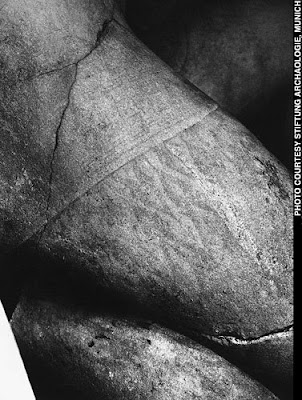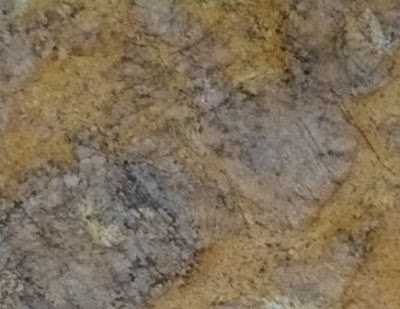
It's Easter and nobody wants to read about kitchen design today. So, I'm going to take advantage in the lull and run my mouth some more about the Renaissance. Indulge me.
The piece I wrote yesterday about the colorized ancient statuary got me thinking about the Italian Renaissance in general and Michelangelo Buonarroti in particular. Michelangelo sculpted his David in what was supposed to have been a commission to outfit the the Santa Maria del Fiore cathedral with a series of 12 old testament figures. The block of marble it's carved from was already on site when the guild responsible for the commission was shopping for a sculptor. Many of the greats of the time were called in to look over the marble, including Leonardo Da Vinci, but no one really wanted to work with the piece of marble in question.
Michelangelo Buonarroti was 26-years-old at the time and he convinced the guild that he deserved the commission. He got it, obviously, and spent the next two years of his life bringing his David to life.
Michelangelo worked in the Mannerist style of the High Renaissance. A key concept in Mannerism is the exaggeration of the human form to make a statement. In addition to David being rendered in a Mannerist style, he's also in a Classically Greek heroic pose. He's standing in contrapposto, his body is turned and his weight is shifted back onto his right leg. This shift back throws David's spine into an S shape and the contrapposto is why David seems to be caught in mid-movement.
Contrapposto and implying movement didn't start with Michelangelo though. Here's a Classical Greek sculpture, the Doryphoros, from 400 BC. Michelangelo and the rest of the Renaissance greats would have studied the Doryphoros and other surviving statues from antiquity. Through their studies, they could recreate and re-interpret these classical forms to make something new and fitting for their own time.

Amazing. While I was rooting around the Internet and looking for images of David, I stumbled up a website that made a point I'd never considered. The site, Michelangelo's David Correctly Oriented is the work of J. Huston McColloch, an Economics professor at the University of Ohio.
When the David was completed, its unveiling was met with a hail of popular acclaim and it never made it up onto the buttresses of the cathedral where it was intended to go. Instead, it was put on display at ground level. It remained at the entrance to Florence's Palazzo Vecchio for several hundred years.
The David is a work of unquestioned genius and it's also a pretty powerful political statement. Unlike most depictions of the story of David and Goliath, Michelangelo's David is unique in that it shows the young man at the moment he decided to take on Goliath. David was usually shown after he'd slain the giant. So David, in contrapposto, is turning to face down his opponent. Make no mistake though, David is a political statement. Arguably, Michelangelo is using the character David to make a political point more than a religious one. David symbolizes the Florentine Republic as the Medici sought to defend themselves from the more powerful Borgias. Michelangelo's David = Cosimo Di Medici, Goliath = Caesar Borgia. Everyone who looked at this statue understood this and they also know how the biblical story turned out. No wonder it was so popular.
The David was moved into Florence's Galeria della Academia in 1873 and has been in that same position ever since. However, the view everyone sees today and the image everybody knows is actually the side view. McCulloch's site has this image of David in its proper orientation. Due to the size of the nave where the David's currently displayed, this perspective is impossible to see without the help of some digital imagery.

That certainly puts him in a whole new light. He looks menacing and poised to spring here and his movement is just not possible to see in the side view. Fascinating. David-as-Medici is easier to see from this perspective as well.
As I mentioned before, David is rendered in a Mannerist style. The Mannerists took liberties with the human form to make a point. Michelangelo made David's hands out of proportion with the rest of his body. David's hands are disproportionately large to show his intelligence and strength. Similarly, his musculature and symmetry are perfect beyond human standards. That's because David is a symbol of the best of humanity, he's not a representation of an actual person. David is an ideal. In typical Mannerist style too, his genitals are scaled down to the point where they indicate his maleness but don't distract. Mannerist, shrunken genitalia shout that this is a serious work, it's not erotica. Most amazing to me is that David's eyes are pointing in two different directions. Here's a close up of his face.

His left eye is looking into the distance, sizing up his opponent. But his right eye is looking down at the viewer. This isn't possible of course, but again it's Mannerist symbolism. David is sizing up his opponent and at the same time he's telling his audience that this is their fight too.
The David has so much going on with it that entire careers have been made out of studying it. But why is this important? Well, it's important because art doesn't happen in a vacuum. No human endeavor does. All human progress is based on the work, thoughts and ideas of the generations before. Henry Moore's work exists because Auguste Rodin's work came before. Rodin's The Thinker drew its inspiration from Michelangelo. Michelangelo carved his David because Polykleitos carved his Doryphoros. Polykleitos drew inspiration from the Egyptians and Persians. And so it goes back to the very dawn of humanity when an early Homo sapiens looked at his hand and decided to draw it on the wall of a cave.
I say this stuff important because it helps me keep my life and my ideas in perspective. The life I lead and the thoughts I have (and the life you lead and thoughts you have) are the direct result of everyone who came before me. Nothing's original. Not my life, not my thoughts, not my likes and not my dislikes.
So to sum it all up, does this look familiar?

This is an image of Hermes Kriophoros (the ram-bearer) from 500 BC.
Now where do you think this image below might have come from?



















